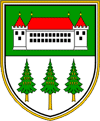
3331 Nazarje
The castle Vrbovec, once called Altenburg, which stands on a massive flat rock on the confluence of rivers Dreta and Savinja, was for the first time mentioned in documents in 1248. It was given its actual structure probably in 1480. The Aquileia patriarchs, counts of Vovržan, counts of Celje and the Habsbourgs are mentioned as owners of the castle until 1615, when it was bought by the diocese of Ljubljana and kept it until the Second World War. The castle was damaged during the Second World War, but now it is restored to host the municipality, museum of forestry and woodcraft, some companies, institutions and a restaurant.
On the hill Gradišče above the confluence of Savinja and Dreta stands a Franciscan monastery with a church of Virgin Mary, which followed the chapel of Loret built in 1625. The monastery and the parish church were built by the Franciscan monks who fled before the Turks from Bosnia in the years between 1632 and 1661. A monastic library was founded in 1752 and was renovated in 1996. Its speciality is the first edition of the Bible by Jurij Dalmatin. Between 1786 and the Second World War there was also a monastic public school. In the 17th century the monastery was also known for its pharmacy. Now it is renovated and serves as place for spiritual practices.
View at castle Vrbovec (Marijingrad – Castle of Mary) on the day of consecration of the chapel of St. Joseph (it was destroyed by Germans during the Second World War) on September 14th 1920 (Archive of museum at Vrbove)
Before the Second World War, Nazarje was a small unknown village. There were a few houses which belonged to Žlaber. A major development of the village began in 1901, when the first industrial sawmill was built. It represents the basis of the wood industry. After the Second World War some other industries were founded, resulting in the fast immigration of big number of population to the area.



